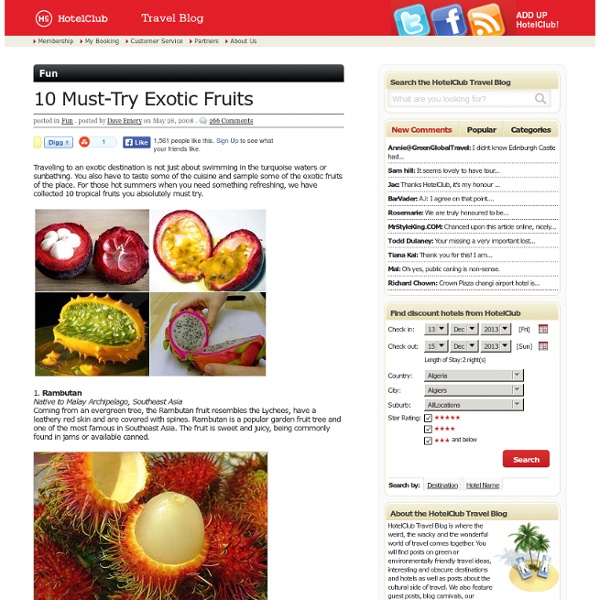10 Most Exotic Fruits - Oddee.com (exotic fruits list)
Squared Watermelon For years consumers have struggled to fit the large round fruit in their refrigerators. And then there was the problem of trying to cut the fruit when it kept rolling around.
What is a mangosteen? — Live in the Philippines
One of my favorite fruits in the Philippines is mangosteen. A lot of people ask me, “Bob, what’s a mangosteen?“ Well, a mangosteen, as I said already, is a fruit. “Ah, it’s some kind of a mango, then?
12 Bizarre Fruits & Vegetables You’ve Never Heard of – And Their Health Benefits
1. Purple Haze Carrots Orange carrots are an excellent source of vitamin A and contain phytochemicals that have antioxidants, anti-bacterial, anti-inflammatory, and other health enhancing qualities. Purple carrots also contain all of these elements, but also include anthocyanins – potent antioxidants. These anthocyanins play an important role in the reduction of risk to diabetes and coronary heart disease. 2.
Mumbai's 13 weirdest fruits
As you walk through the street markets of Mumbai, you’re bound to stumble upon some unfamiliar fruits, with vendors trudging their carts along in search of willing buyers. You'll want to look in Crawford Market, Dadar (West) station market, Parle (East) station market and Santacruz (West) station market. Another sure way to find them would be in the vicinity of schools after the closing bell, where kids flock to get their sour fruit fix. 1.
Garcinia mangostana
[edit] Garcinia mangostana Classification System: APG III (down to family level) Main Page Regnum: Plantae Cladus: Angiosperms Cladus: Eudicots Cladus: Core eudicots Cladus: Rosids Cladus: Eurosids I Ordo: Malpighiales Familia: Clusiaceae Subfamilia: Clusioideae Genus: Garcinia Species: Garcinia mangostana Name[edit]
List of Durio species
Among the thirty known species of Durio, so far nine species have been identified to produce edible fruits. However, there are many species for which the fruit has never been collected or properly described and it is likely that other species with edible fruit exist.[1] The currently known nine species of edible durians are: The other species, which haven't been identified to produce edible fruits are: Durio acutifolius (Mast.) Kosterm.: distributed in Kalimantan and Sabah.Durio affinis (Becc.): distributed in West Kalimantan and Sabah.Durio beccarianus (Kosterm. & Soegeng.): distributed in West Kalimantan.Durio bukitrayaensis (Kosterm.)Durio burmanicus (Soegeng.)Durio carinatus (Mast.): distributed in Peninsular Malaysia, Borneo.Durio crassipes (Kosterm.): distributed in Tenom and Sipitang areas of Sabah.Durio excelsus (Korth.)
Food Testing Experts: The 12 Weirdest Looking Fruits
Food Testing Experts: The 12 Weirdest Looking Fruits #12. KumquatIt looks like an orange but sized as a grape. You can eat it like a grape too, skin and all. Kumquats are sweet, sour, and have lots of fiber.
Rambutan
The rambutan (/ræmˈbuːtən/; taxonomic name: Nephelium lappaceum) is a medium-sized tropical tree in the family Sapindaceae. The fruit produced by the tree is also known as rambutan. According to popular belief and the origin of its name, rambutan is native to Indonesia and Malaysia. The earliest record of rambutan trees show that they were cultivated by the Malayan jungle tribes around their temporary settlements, a practice followed to date.[3] Rambutan trees grow naturally in Thailand, Vietnam, the Philippines, and elsewhere in Southeast Asia, although its precise natural distribution is unknown.[4] It is closely related to several other edible tropical fruits including the lychee, longan, and mamoncillo.[4] It is native to the Indonesian Archipelago,[5] from where it spread westwards to Thailand, Burma, Sri Lanka and India; northwards to Vietnam, and the Philippines.[4] A species regularly sold in Costa Rican markets may be known as "wild" rambutan.
Carambola
Unripe carambolas on the tree Carambola, also known as starfruit, is the fruit of Averrhoa carambola, a species of tree native to the Philippines, Indonesia, Malaysia, India, Bangladesh and Sri Lanka. The fruit is popular throughout Southeast Asia, the South Pacific and parts of East Asia. The tree is also cultivated throughout non-indigenous tropical areas, such as in Latin America, the Caribbean, and the southern United States.
Purple mangosteen
"Mangosteen" redirects here. This may also refer to the entire genus Garcinia. The purple mangosteen belongs to the same genus as the other, less widely known, mangosteens, such as the button mangosteen (G. prainiana) or the charichuelo (G. madruno). A description of mangosteen was included in the Species Plantarum by Linnaeus in 1753. Tree and fruit[edit] Mangosteen tree
Durian
The edible flesh emits a distinctive odour that is strong and penetrating even when the husk is intact. Some people regard the durian as having a pleasantly sweet fragrance; others find the aroma overpowering and revolting. The smell evokes reactions from deep appreciation to intense disgust, and has been described variously as rotten onions, turpentine, and raw sewage.
Ten of the World's Strangest Fruits - Chef's Blade
News/Culture >> Browse Articles >> Culinary Oddities News/Culture >> Browse Articles >> Food Writing Bored of bananas?



